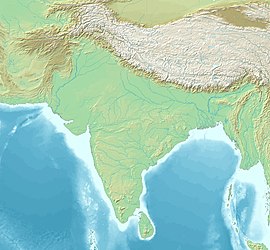First Battle of Eran
The First Battle of Eran[4] was a key engagement of the First Hunnic War that took place in 498 CE at Airikana (Eran), India. It was fought between the Gupta Empire and the invading army of Alchon Huns. The battle involved the Emperor Budhagupta, his viceroys, and Toramana, an acclaimed Hunnic king. The confrontation had significant consequences for the political and territorial situation in the region. The conflict concluded with a victory for the Alchon Huns that influenced subsequent events in the region.[5]
| First Battle of Eran | |||||||||
|---|---|---|---|---|---|---|---|---|---|
| Part of First Hunnic War | |||||||||
Find spots of epigraphic inscriptions (red dots) indicating local control by the Alchon Huns in India between 500 and 530 CE,[1] with neighbouring polities,[2] and territorial extent of the Alchon Huns (brown).[3] | |||||||||
| |||||||||
| Belligerents | |||||||||
| Gupta Empire | Alchon Huns | ||||||||
| Commanders and leaders | |||||||||
|
Budhagupta Suraśmicandra Mātṛviṣṇu † Dhanyaviṣṇu |
Toramana Harigupta Bhuta | ||||||||
Location of the battle within India | |||||||||
Prelude
Lua error in Module:Location_map/multi at line 27: Unable to find the specified location map definition: "Module:Location map/data/Hephthalites" does not exist.
The invasion of the Hepthalites followed a geographical trajectory similar to that of the Indo-Greeks during the post-Maurya period and was later mirrored by the Turks. Like the Indo-Greeks and the Turks, the Hunas initially consolidated their power in the Punjab region. After their defeat by Skandagupta, they shifted their focus back to Persia.[6] In 456 CE, Yazdegerd II continued his struggle against them. Following his death in 457 CE, the Sassanian Empire came under the rule of Peroz I, who was defeated by the Hephthalite king Akun (or Akhshunwar) and forced to pay tribute.[7][8]
In 484 CE, Peroz I launched an offensive against the Hephthalites but was defeated and killed. According to Chavannes, based on Chinese historical accounts, by around 500 CE, the Huna Empire included Tokharistan, Kabulistan, and Zabulistan, with Gandhara and Chitral being the only regions of "India proper" under their control. The Chinese traveler Song Yun, who visited Gandhara in 520 CE, provided further details on the state of the region during that time:
This is the country which the Ye-thas destroyed, and afterwards set up a Tch'e-le (a tegin, prince or the member of the royal family) to be the king over the country; since which event two generations have passed.[9]
— Song Yun, The Chinese traveler
Song Yun's account suggests that the power of Jaūvla extended to Gandhara approximately two generations before his visit in 520 CE. The identity of the Huna king who led the conquest of Gandhara remains uncertain. However, it is plausible that King Ramanila, known only from his coins, preceded Toramana and played a key role in the Huna conquest of the region.[10] Nevertheless, it cannot be ruled out that Ramanila belonged to a different dynasty than that of Toramana.[11]
Toramana, a prominent ruler of the Alchon dynasty, successfully established political and cultural dominance in the Punjab, which fostered his imperial ambitions. During this time, the Sasanian Empire was in turmoil following a coup against Kawad I in 496 CE. Although Kawad I regained power in 498 CE, his authority remained heavily reliant on the Hephthalites, the Hunnic rulers north of the Hindu Kush.[13]
Capitalizing on this opportunity, Toramana launched an invasion of northern and western India from the Punjab, possibly from a stronghold on the banks of the Candrabhaga River. Within a year, he assumed the title of Maharajadhiraja, or Emperor, as evidenced by the inscription on the Boar of Eran, which describes him as 'the glorious Toramana, of great fame and great lustre.'[13]
- ↑ Bakker, Hans T. (2020-03-12). The Alkhan: A Hunnic People in South Asia. Barkhuis. ISBN 978-94-93194-00-7.[page needed]
- ↑ Schwartzberg, Joseph E. (1978). A Historical atlas of South Asia. Chicago: University of Chicago Press. p. 25. ISBN 0226742210.
- ↑ Schwartzberg, Joseph E. (1978). A Historical atlas of South Asia. Chicago: University of Chicago Press. p. 145, map XIV.1 (k). ISBN 0226742210.
- ↑ Bakker, Hans T. (2020-03-12). The Alkhan: A Hunnic People in South Asia. Barkhuis. p. 33. ISBN 978-94-93194-00-7.
Alkhan invasion in Western India in first year of the reign of Mahārājādhirāja Toramāna First Battle of Eran (Betwā Valley), in which Mātṛviṣṇu is probably killed. His younger brother Dhanyaviṣṇu installs a Varāhamūrti in Eran (SB X.032).
- ↑ S. R. Goyal (1967). A history of the Imperial Guptas. With a Foreword by R. C. Majumdar. pp. 337–342.
- ↑ History Of Ancient And Early Medieval India From The Stone Age To The 12th Century. p. 1085.
- ↑ S. R. Goyal (1967). A history of the Imperial Guptas. With a Foreword by R. C. Majumdar. p. 337.
- ↑ Keay, John (1999). India : a history. Internet Archive. London : HarperCollins. p. 144. ISBN 978-0-00-255717-7.
- ↑ S. R. Goyal (1967). A history of the Imperial Guptas. With a Foreword by R. C. Majumdar. p. 337.
- ↑ R. C. Majumdar (1970). History and Culture of the Indian People, Volume 03, The Classical Age. Public Resource. Bharatiya Vidya Bhavan. p. 36.
- ↑ S. R. Goyal (1967). A history of the Imperial Guptas. With a Foreword by R. C. Majumdar. p. 338.
- ↑ ALRAM, MICHAEL (2003). "Three Hunnic Bullae from Northwest India" (PDF). Bulletin of the Asia Institute. 17: 180, Figure 11. ISSN 0890-4464. JSTOR 24049314.
- ↑ 13.0 13.1 Cite error: Invalid
<ref>tag; no text was provided for refs named:4


